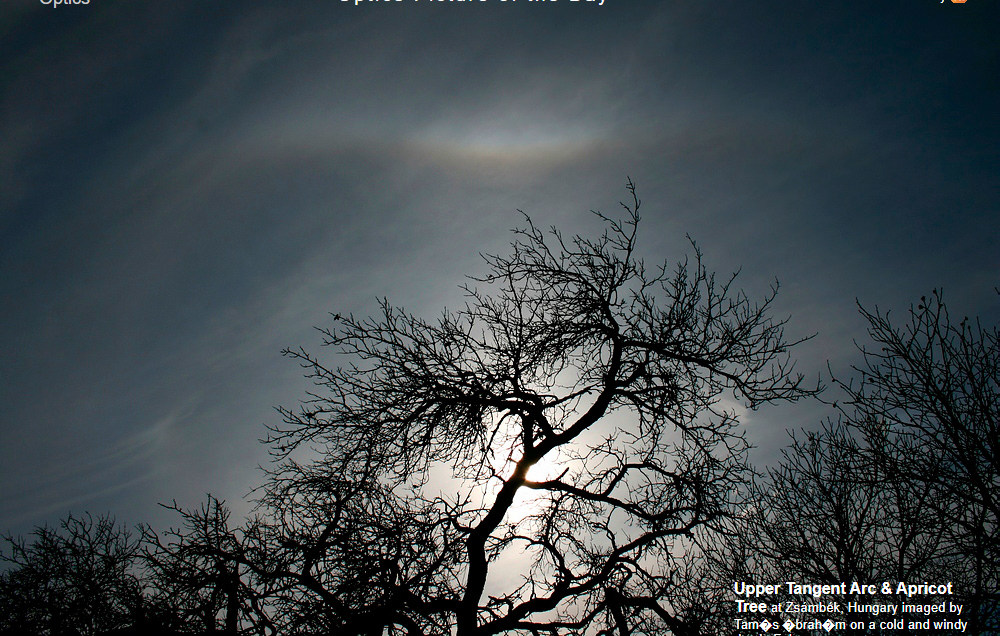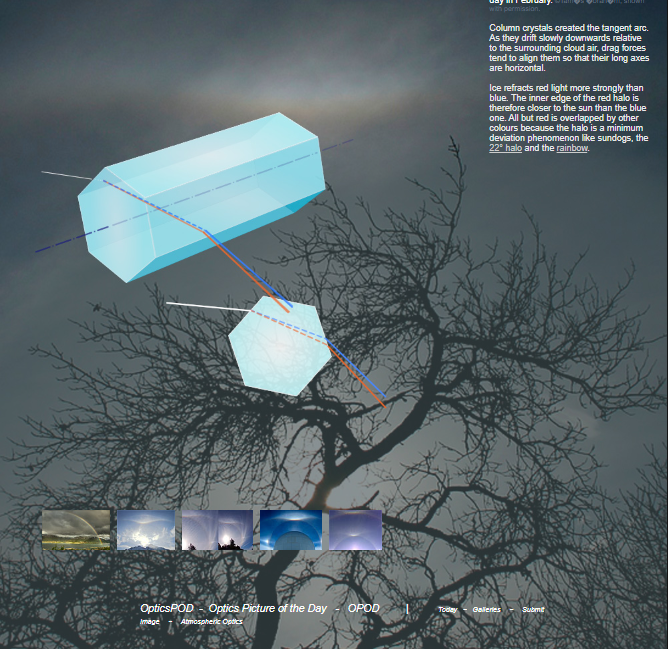Lone Upper Tangent
Lone Upper Tangent: A Fascinating Atmospheric Optics Phenomenon
When it comes to atmospheric optics, there are a myriad of intriguing phenomena that can occur in the sky. One such phenomenon is the "Lone Upper Tangent." This captivating optical effect is created by column crystals, which slowly descend through the surrounding cloud air and align themselves horizontally due to drag forces.
The tangent arc, which is formed by these column crystals, is a stunning display of light refraction. Ice has a greater refractive index for red light compared to blue light, resulting in the inner edge of the red halo being closer to the sun than the blue one. The halo itself is a minimum deviation phenomenon, similar to sundogs, the 22° halo, and the rainbow.
Now, let's delve deeper into the intricacies of the Lone Upper Tangent and explore some fascinating aspects of this atmospheric optics phenomenon:
1. Formation of Column Crystals
Column crystals are essential for the creation of the Lone Upper Tangent. These hexagonal ice crystals take shape as they fall through the atmosphere. As they descend, drag forces act upon them, causing them to align horizontally. This alignment is crucial for the subsequent formation of the tangent arc.
2. The Role of Light Refraction
Light refraction plays a significant role in the creation of the Lone Upper Tangent. When sunlight passes through these column crystals, it undergoes refraction. The refraction causes the different colors within the light spectrum to bend at different angles, resulting in the separation and dispersion of colors.
3. Red Light Refraction
Ice has a higher refractive index for red light compared to blue light. As a result, red light is refracted more strongly than blue light when passing through the column crystals. This disparity leads to the inner edge of the red halo being closer to the sun than the blue halo.
4. Overlapping of Colors
While the red halo is clearly visible due to the stronger refraction of red light, the other colors in the spectrum overlap with one another. This overlapping occurs because the halo is a minimum deviation phenomenon, similar to sundogs, the 22° halo, and the rainbow. The intricate interplay of light refraction and overlapping colors creates a mesmerizing visual spectacle.
5. Unique Conditions for Observation
Observing the Lone Upper Tangent requires specific atmospheric conditions. The presence of column crystals, combined with the appropriate angle of sunlight, is crucial for the formation of this optical phenomenon. These conditions are often found in cold and windy environments, making it a rare occurrence to witness the Lone Upper Tangent.
6. Similarities to Other Atmospheric Optics Phenomena
The Lone Upper Tangent shares similarities with other atmospheric optics phenomena, such as sundogs, the 22° halo, and rainbows. All these phenomena involve the refraction and dispersion of light in different ways, resulting in the formation of distinct visual displays in the sky. Exploring these connections helps us gain a deeper understanding of the underlying principles behind these mesmerizing natural occurrences.
In conclusion, the Lone Upper Tangent is a captivating atmospheric optics phenomenon that showcases the interplay between light refraction, ice crystals, and overlapping colors. Understanding the formation and intricacies of this phenomenon adds to our knowledge of atmospheric optics and allows us to appreciate the beauty and complexity of the natural world around us. So keep your eyes on the sky, as you never know when you might be fortunate enough to witness the mesmerizing display of the Lone Upper Tangent.

Upper Tangent Arc & Apricot Tree at Zsámbék, Hungary imaged by Tam�s �brah�m on a cold and windy day in February. ©Tam�s �brah�m, shown with permission.
Column crystals created the tangent arc. As they drift slowly downwards relative to the surrounding cloud air, drag forces tend to align them so that their long axes are horizontal.
Ice refracts red light more strongly than blue. The inner edge of the red halo is therefore closer to the sun than the blue one. All but red is overlapped by other colours because the halo is a minimum deviation phenomenon like sundogs, the 22° halo and the rainbow.

Note: this article has been automatically converted from the old site and may not appear as intended. You can find the original article here.
Reference Atmospheric Optics
If you use any of the definitions, information, or data presented on Atmospheric Optics, please copy the link or reference below to properly credit us as the reference source. Thank you!
-
<a href="https://atoptics.co.uk/blog/lone-upper-tangent-2/">Lone Upper Tangent</a>
-
"Lone Upper Tangent". Atmospheric Optics. Accessed on April 28, 2024. https://atoptics.co.uk/blog/lone-upper-tangent-2/.
-
"Lone Upper Tangent". Atmospheric Optics, https://atoptics.co.uk/blog/lone-upper-tangent-2/. Accessed 28 April, 2024
-
Lone Upper Tangent. Atmospheric Optics. Retrieved from https://atoptics.co.uk/blog/lone-upper-tangent-2/.